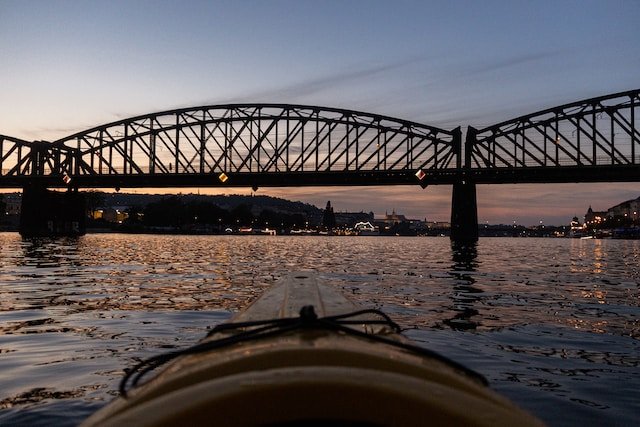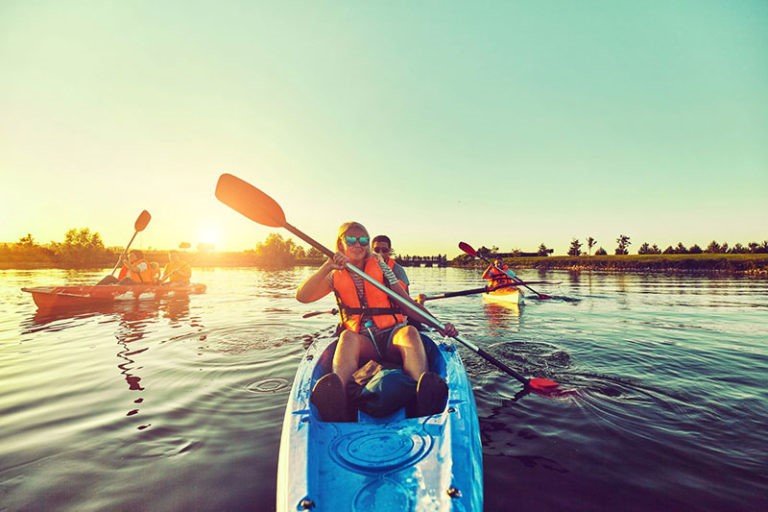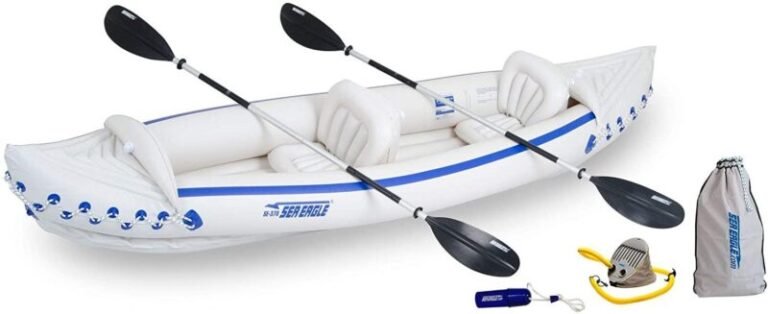A Detailed Guide To Kayaking At Night

Night Kayaking Guide
When most people think of kayaking, they imagine paddling in a waterbody of choice in the daytime. The fact that you are reading this article proves that you want to verify this fact, you want to be sure you can enjoy your favorite sport regardless of whether it is day or night.
Kayaking at night is indeed possible and as you can imagine, it is quite different from kayaking during the day. For one most people retire at night so you will probably be on the water by your lonesome with no crowd there to spoil the magic.
Fishing is more fun at night and the stars, moonlight, or city lights reflecting off the water offer a beautiful view. You will fall in love with nature all over again.
However, before you start kayaking at night, you must familiarize yourself with what that entails. It is important you learn the rules.
Dive into this article where all you need to know concerning kayaking at night is explained to equip you for a fun and safe paddling session on the water.
Is It Legal To Kayak At Night?
The question of whether or not kayaking at night is legal is one commonly asked by kayakers who wish to broaden their kayaking horizons and enjoy the charms of the water when the sun is no longer in the sky and the water is free from the crowd.
Nocturnal kayaking can be a peaceful and serene experience. It can also be dangerous and is therefore not recommended without the proper preparation and safety gear. Is it legal to kayak at night?
In general, yes, but there are some exceptions that vary by state. Any state or national park that prohibits night kayaking will most likely do so because it can be unsafe and disruptive to wildlife, but all things considered, you should be able to kayak at night without attracting problems from law enforcement.
As laws regarding kayaking at night vary from state to state, it is up to you to look up your state’s laws to be sure you are not violating them.
The Coast Guard which regulates boating activities in all states classifies kayaks as human-powered or oar-driven vessels, and as such, standard lighting is expected of them.
The Coast Guard expects anyone kayaking at night to have the same lights as a sailboat or a torch or flashlight if unable. The rule is stated below.
“A vessel under oars may exhibit the lights prescribed in this rule for sailing vessels, but if she does not, she shall exhibit an all-around white light or have ready at hand an electric torch or lighted lantern showing a white light which shall be exhibited in sufficient time to prevent a collision.”
Besides this rule, specific laws and safety precautions exist in each state to guide kayaking at night. It is up to you to study them and adhere to them.
Is It Safe To Kayak At Night?
As we all know, being permitted to do something and being safe while doing it are two different things. It should thus come as no surprise to learn that kayaking at night is inherently dangerous, even more so than kayaking during the day.
The usual dangers of daytime kayaking include dehydration, drowning, capsizing, hypothermia, and bad weather, but nighttime adds low light conditions, poor visibility, and a high probability of being disoriented to the list.
I say this not to scare you from night kayaking, but to help you prepare yourself. Knowing what to expect on your trip and not underestimating the dangers of your endeavors is the first step to ensuring your safety on the water.
The major problem of kayaking at night is poor visibility. The major sense of a kayaker is eyesight. He depends on it to safely navigate his vessel and nighttime brings with its charms low light conditions.
Ensuring your safety then implies that you invest in seeing your surroundings and making yourself easily seen. Never assume that others on the water will follow safety precautions. Always follow them for everyone and you will avoid accidents.
The next issue with kayaking at night is disorientation. You will notice that once the sun sets, even a very familiar area begins to look alien, and if care is not taken, you could get disoriented and alter your course.
Righting an altered course at night is more difficult than it sounds, so you want to avoid this predicament altogether. Pay extra attention to your surroundings at night than you would during the day to ensure your safety.
The last thing you should watch out for is wildlife. Before kayaking in a waterbody whether during the day or at night, you should make it your business to know which living things will be sharing the water with you.
You want to be especially careful at night as animals that are sedentary during the day may be more active at night (like alligators), and you don’t want to confront an animal while not being able to see your surroundings properly.
Rules Governing Night Kayaking
Regardless of whether you are kayaking in the day or at night, kayaking safety rules remain unchanged.
Be mindful of your surroundings, be ready for emergencies, check the weather forecast before planning your trip, etc. Naturally, kayaking at night necessitates extra safety rules, and those rules are discussed below.
Rule 1: Make Sure Others Can Easily See You
As you know by now, the greatest problem of kayaking at night is poor visibility, so ensuring that others can see you is a significant step in preventing collisions. You can make yourself visible in two ways, using kayak lights and/or sound.
If you opt to use sound as a way to be seen, you will want to make use of a marine air horn or a long-range whistle. Just make sure the decibel rating is at least 120dB and above, and you will be good to go.
The idea is to make enough noise that any person approaching you will quickly know that someone is out there. If you can’t afford a light that is bright enough and feel you must kayak that night, using sound to be seen should not be overlooked.
If you prefer light as your method of being seen, the kayak light you use should be Coast Guard-approved.
You can make use of a 360-degree white light mounted on a pole on your kayak to make yourself visible to others, or at the very least, a flashlight is required for your safety. Make sure you are easily seen on the water and accidents will be far from you.
Having emergency lights is also an important part of being seen. Invest in a flasher or strobe light that will go off when you are in trouble to ensure help finds you.
You should also be familiar with the lights on vessels. To help vessels to be easily seen, red and green running lights or side lights are often employed on kayaks.
The red light is always positioned on the port (the left side), while the green light is always positioned on the starboard (the right side).
Reading Side Lights
Knowing how to read side lights is an important skill anyone who wants to kayak at night must master.
The green light is always on the right while the red light is always on the left so their position on a vessel as you paddle at night gives you an idea of the direction in which it is going.
- If you see green and red lights on a vessel, with the red light on your left, the vessel is moving away from you.
- If you see green and red lights on a vessel, with the red light on your right, the vessel is moving toward you.
- If you see a red light on the side of a vessel ahead of you, the vessel is moving from your right to your left.
- If you see a green light on the side of a vessel ahead of you, the vessel is moving from your left to your right.
When should you switch on your lights?
If you come out to kayak when it is already dark, you probably already have your light on. But if you hit the water before the sun sets and darkness begins to fall, you may find yourself wondering when is the appropriate time to turn on your lights.
You should on your lights before darkness sets to be on the safer side. Waiting for the dark before switching your light on is a risk, and kayaking at night is dangerous enough without taking unnecessary risks.
Rule 2: Make Sure You Can See
The next rule is ensuring you can see. Having good kayak lights can help you be seen but it does not necessarily mean that you will be able to see, especially when using white light.
The truth is that white light reduces your ability to see in the dark so if your light is ill-positioned, you will have trouble seeing your surroundings. On this note, I want to emphasize making use of lights suspended above you so you can see easily with little ill effect from the white light.
The truth is that if you make use of headlamps or flashlights as your primary source of light, not only could you end up shining light in another boater’s eyes and disorienting him, but you also risk impairing your ability to see too.
This is because reflections from the water and the surface of your kayak will distract you and as the light is not stable, it will move constantly as you move rendering you more unsafe.
Rule 3: Plan Your Route
You’ve probably heard that planning your route on a kayaking trip is important, I’m telling you now that it is very important at night.
Keep in mind that one of the dangers of kayaking at night is disorientation, and you will take this point seriously. Planning your trip entails mapping out the area you will kayak at night before the kayaking such that you are certain you can find your way in the dark.
As a safety precaution, you should avoid water bodies with traffic for night kayaking, especially if you are just trying it out.
Planning your route is not enough, you have to ensure you stick to your schedule. This implies taking the waves, currents, and tides into consideration, making use of GPS, compass, or maps to find your way, and employing any other safety measure you know will safely get you home.
If you are kayaking in a pretty deserted place, for instance, you might want to leave a reliable light on at your launching point to make it easy for you to find your way on your return.
Rule 4: Bring Safety Gear
Safety gear will help keep you safe on the water. first and foremost, you should always put on your life jacket the moment you get to shore and not take it off unless you are leaving. Other safety gear include:
- A VHF radio: This is recommended over a smartphone if you will be kayaking in places with poor network reception. This is because these radios are not affected by that as they rely on satellites. If you won’t be kayaking in zones with poor reception, a smartphone will do just fine.
- Spare clothes: To change into after paddling, especially if you get wet. Your spare clothes and kayak clothing should both be intended to provide warmth. Remember that the air is cooler at night. Having a waterproof jacket or sweater at hand would also be very handy on chilly nights.
- A first aid kit: To treat minor injuries.
- Food and drinking water: To keep your strength.
- A noise maker: It could be an air horn or a whistle, it is to help with being seen.
- A dry bag: To keep all personal items that you don’t want to get wet like your smartphone, ID, etc.
- GPS: To help you find your way if you go off course.
- Compass and map: Manual backup in case technology fails you to help you find your way.
- Spare batteries and lamp: To ensure you can see your surroundings and be seen even if something happened to your original lights.
Make sure all safety gear is easily accessible. The gear won’t be of much use if you struggle to access it when the need arises.
Safety Precautions for Kayaking at Night
By now, you are aware that night kayaking can be both enjoyable and dangerous. Adhering to safety precautions is always a smart move in ensuring your safety, so knowing safety precautions is indispensable. Safety precautions for night kayaking include:
- Always wear your life jacket while kayaking, it could be the difference between life and death on the water, especially when there is a delay in rescue.
- Always check the weather forecast before planning your trip. Kayaking at night is dangerous enough without bad weather, so avoid unnecessary risks. Keep checking weather updates periodically and leave the water if any foul weather is predicted.
- Always check the tides: If you intend to kayak in waters heavily influenced by the tides (like seas, oceans, and brackish waters), you will be doing yourself a favor by checking all information on the tides while planning your trip. Know when the tides will change, how greatly they fluctuate, and any other important knowledge to ensure your safety. You don’t want to get stranded in the water at night, so check all tide predictions.
- Be aware of your surroundings at all times. This is very important as while light and noise will help you prevent collisions with other vessels, they will not protect you from accidents with non-living things if you are oblivious to your surroundings. As you enjoy the beauty of night kayaking, make sure you remain vigilant and safety-conscious.
- To see better in low light conditions, look approximately 20 degrees off the center to the side of things in your vicinity. Take this precaution to heart if you are kayaking in the ocean lest you learn from experience that looking at waves square on results in you misjudging their size and location.
- Gather information from local paddling clubs or government agencies on the weather and tidal pattern of the waterbody you intend to kayak in. You will notice it will give you a good idea of what to expect.
- If you enjoy paddling alone at night, you should practice self-rescue techniques. You want these techniques to become second nature as there will be a visibility problem to worry about should you be in trouble. Being able to rescue yourself can also keep you alive if you are kayaking in waters with little traffic or if there is a delay in rescue.
- Make sure all your lights are waterproof. It wouldn’t do to be plunged into darkness because your lights go wet.
- If possible, avoid waterbodies with low-head dams. These dams can be quite difficult to spot during the daytime, so avoiding them at night is a wise course of action. If your waterbody of choice has a low-head dam, make sure you know where it is and take all precautions to avoid running into it on the water.
- Always inform someone of your plans before hitting the water. Give them your planned route, estimated time of arrival, and how long they should wait before sounding an alarm for rescue. If you don’t have family or friends nearby to await your arrival, you can always leave your paddling plan at a local Coast Guard station so they can be on the lookout and come to your aid should the need arise.
Kayaking is undeniably fun, and kayaking at night opens a brand new door of opportunities. The tranquillity of the night and the reflection of the lights on the water add to the charm and you can’t help but fall in love with nature all over again.
However, assuming you can approach kayaking at night the same way you would kayaking during the day is very unrealistic and a recipe for disaster.
To get started on night kayaking, you should start at a place you are very familiar with paddling during the day to make navigation less challenging. For your first few tries, you can just paddle a little and get a feel of what is different.
Safety when kayaking at night is of utmost importance, and it cannot be overemphasized. The golden rule is: See and Be Seen.
Make sure you can see others and they can also see you. Abide by safety rules and precautions, and you will be safe. Have fun on the water!






